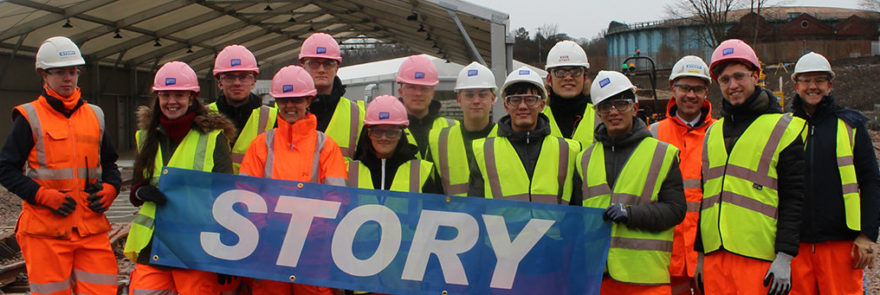
Twelve Civil Engineering students from Heriot Watt University, ranging from first years to PhD students, were welcomed to Story’s SPT site in Glasgow to get a first-hand look at what a live site looks like.
The students were talked through the works carried out so far by Story Contracting on behalf of Ansaldo STS by Scheme Project Manager, James O’Sullivan, before being given a guided tour of the site itself by Project Agent, Rosie Miller.
The tour of the site, which supports Strathclyde Partnership for Transport (SPT) with their plans to upgrade the Glasgow Subway Network, gave the students an overview of how the design and construction of the new test track facility for the testing and commissioning of a new fleet of driverless trains, are being delivered.
Once the site tour had been completed, the students then travelled to SPT’s Broomloan Depot and received tours of their ongoing works to build a new wheel lathe and blast-proof Operations Control Centre, giving the students a sight of numerous different types of civil engineering works in one afternoon.
Professor Ian Smith of Heriot Watt University said: “Many thanks once again for putting the time aside yesterday to welcome the Heriot Watt students to what was a fantastic site visit. It exceeded my expectations as the buzz, interest and enthusiasm shown by the students was really remarkable. They all thoroughly enjoyed it and found it an extremely relevant and worthwhile visit. I’m sure you’ve inspired a few future rail engineers there! Even the classic Scottish site weather towards the end didn’t dampen their enthusiasm!
“Many thanks once again, your efforts and time were greatly appreciated by us all.”
The visit comes on the back of a donation of materials from Story Contracting to the university’s innovative Postgraduate Research Lab.
Surplus rail track from our project at Edinburgh Waverley was given to the lab, the biggest rail testing rig in the UK, where students are testing the viability of retained sub-base and ballast, enabling rail to be constructed with a reduced land requirement.
Click here to view a video from BBC News explaining the students’ research in more detail.

















